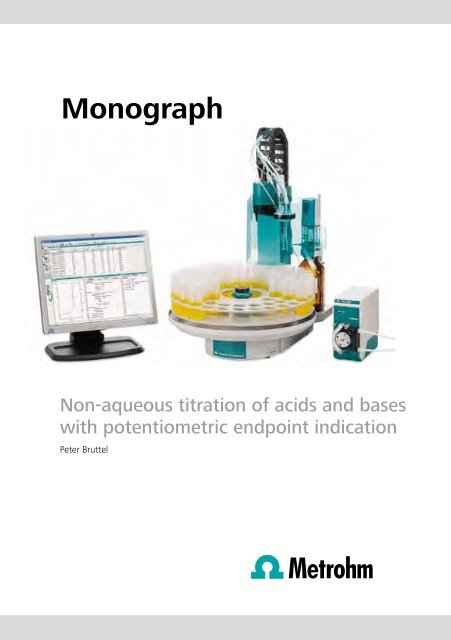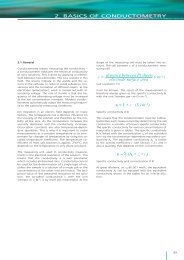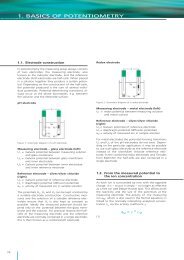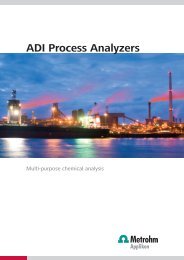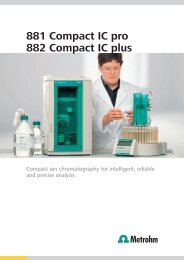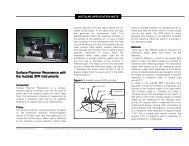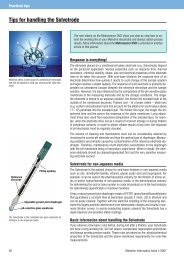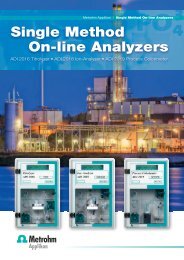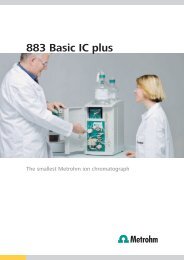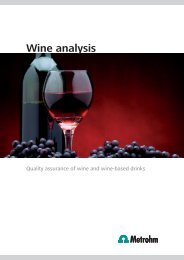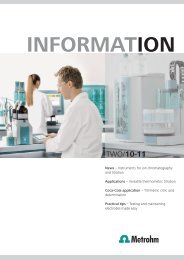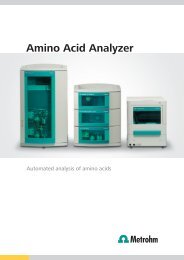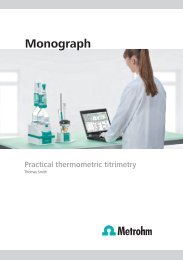Monograph - Metrohm
Monograph - Metrohm
Monograph - Metrohm
Create successful ePaper yourself
Turn your PDF publications into a flip-book with our unique Google optimized e-Paper software.
<strong>Monograph</strong>Non-aqueous titration of acids and baseswith potentiometric endpoint indicationPeter Bruttel
Non-aqueous titration of acids and baseswith potentiometric endpoint indicationPeter BruttelAll rights reserved, including translation rights.Printed in Switzerland by <strong>Metrohm</strong> Ltd., CH-9101 Herisau08.1999 – 8.024.5003Non-aqueous titration of acids and bases with potentiometric endpoint indication
ContentsContents1. Preface ................................................................................................... 32. Important terms ...................................................................................... 43. Remarks concerning solvents for non-aqueous titrations ....................... 54. Apparatus and accessories used ........................................................... 95. Titration of acids ..................................................................................... 96. Titration of bases .................................................................................. 127. pK A values of some selected acids ....................................................... 148. pK B values of some selected bases ...................................................... 159. Dielectric constants (DC) of some selected solvents............................ 1610. Literature references ............................................................................ 17Compilation of results: bases as titrants ......................................................... 18Standard deviations of the electrode signals ........................................ 24Titration curves obtained with the SolvotrodeLiCl sat. in ethanol ........................................................................... 250.4 mol/L TEA-Br in ethylene glycol ................................................ 31Compilation of results: acids as titrants .......................................................... 37Standard deviations of the electrode signals ........................................ 44Titration curves obtained with the SolvotrodeLiCl sat. in ethanol ........................................................................... 450.4 mol/L TEA-Br in ethylene glycol ................................................ 492 Peter Bruttel
Preface1 PrefaceNon-aqueous titrations continue to play an important role in analysis, no matterwhether in the determination of acid or base numbers in oils and fats, for quantifyingproducts with different acidic or basic strengths separately or for titratingsubstances that are insoluble in water.This monograph is not intended to be a textbook; it should rather help the practicalchemist to decide which solvents, electrodes, titrants and instruments are themost suitable ones for the particular application. The monograph makes no claimto be complete; it also assumes a certain basic knowledge of potentiometricanalysis.Non-aqueous titrations are not without their problems. Effects are experiencedthat do not occur in this form in purely aqueous systems. The main problems are:a) interferences caused by static electricity andb) the response behaviour of the electrodes used.As far as a) is concerned a wide range of different measures have already beenintroduced or at least tried. These include everything from titration in earthedsolutions through shielding the complete titration system (Faraday cage) and upto the use of differential amplifiers and the three-electrode technique. This lattertechnique has its advantages in many cases, above all wherever work is carriedout in nonpolar solvents with nonpolar samples (e.g. petrochemical products).The type of electrode(s) used also plays a major role, which brings us to point b).Many years of experience involving non-aqueous titration have resulted in<strong>Metrohm</strong> developing a special electrode that is particularly suitable for non-aqueoustitration – the 6.0229.100 Solvotrode. It meets all the demands that must beplaced on such an electrode: large membrane surface, as small a membraneresistance as possible, rapid response, optimally designed ground-joint diaphragm,excellent shielding and appropriate electrolyte solutions.Non-aqueous titration of acids and bases with potentiometric endpoint indication 3
Important terms2 Important termsAmphiproticAppreciable self-dissociation (e.g. 2 CH 3 OH < > +CH 3 OH 2 + CH 3 O – ), also knownas polar.AproticNo self-dissociation, also known as nonpolar.Dielectric constant (DC)Proportionality factor between the electric displacement D and the electric fieldstrength E in a vacuum. The DC depends strongly on temperature. Solvents witha higher DC promote the electrolytic dissociation of electrolytes. The DC is asubstance-specific constant that depends to a large extent on the molecular structure.It is measured with so-called decameters. In nonpolar solvents (having asmall DC) even strong electrolytes (e.g. NaCl, HClO 4 , etc.) are only weakly dissociated.DissociationFormation of ions, e.g. CH 3 COOK < > CH 3 COO – + K +LevellingEqualising of base or acid strengths. In this case separation is not possible. Example:sulphuric acid:During the titration, e.g. in acetone, two well-differentiated steps are obtained. Inan aqueous titration levelling occurs; only one potential jump is obtained, whichcorresponds to the sum of the two acids of different strengths.pK valueAcidity or basicity constantsK A = [H 3 O + ] [A – ] / [HA]K B = [BH + ] [OH – ] / [B]The negative logarithms of these values are known as pK A and pK B , respectively;they are analogous to the pH value. The smaller the value, the «stronger» theacid or base. In order to achieve a separation in an aqueous titration the differencebetween the pK values should be approx. 5. In suitable non-aqueous solventsa difference of 2 to 3 is sufficient.4 Peter Bruttel
Remarks concerning solvents for non-aqueous titrations3 Remarks concerning solvents for non-aqueous titrations3.1 Amphiprotic solvents – acidic3.1.1 Glacial acetic acid (HAc)Solvent for bases in particular. The water content should be less than 1%. Insome cases acetic anhydride is added. However, this can lead to acetylation andtherefore to incorrect results (primary, secondary and tertiary amines). For thetitration of weak bases it is better to add an aprotic solvent, e.g. dioxane or toluene.3.1.2 Formic acidIs only used for the titration of the weakest bases, e.g. caffeine (pK B = 13.4) orurea (pK B = 13.8). The water content should not exceed 1%. Should not be usedwith short-chain alcohols – esterification!3.1.3 Trifluoroacetic acidSuitable as a solvent for the weakest bases, where acetic anhydride cannot beused because of acetylation. An expensive solvent!3.1.4 OthersPropionic acid, cresols and phenol are not very important. Cresols are used inmixtures, e.g. with chloroform, as solvents for determinations of terminal aminogroups in polyamides. As phenol has excellent solubilising properties for thesalts of organic bases, its use with a mixture of chloroform and acetonitrile hasbeen suggested for these applications.3.2 Amphiprotic solvents – basic3.2.1 EthylenediamineUsed as a solvent for weak acids. Has good solubilising properties. Has a levellingeffect for strong acids – carboxylic acids and phenols can nevertheless beseparated. It fumes when exposed to the air, is toxic and corrosive and also hasan unpleasant odour. Takes up water and carbon dioxide from the air (blank values).3.2.2 ButylamineSimilar properties to ethylene diamine, but has slightly smaller solubilising properties.Offensive odour.3.2.3 BenzylamineIf it has to be a solvent from this class (3.2), then this one. Similar to butylamine,but better solubilising properties and less offensive odour.Non-aqueous titration of acids and bases with potentiometric endpoint indication 5
Remarks concerning solvents for non-aqueous titrations3.3 Amphiprotic solvents – neutral3.3.1 Methanol and ethanolCompared with water they have lower dielectric constants but similar acidity andbasicity. Not suitable for the determination of weak acids such as phenol. However,the carboxyl groups of dicarboxylic acids and the two acid groups of sulphuricacid can be separated. They also have certain solubilising properties fororganic compounds that water does not possess.3.3.2 IsopropanolHas excellent solubilising properties, e.g. for hydrocarbons, and is often used asa solubility promoter between these and water. As a secondary alcohol it is aweaker «acid» than the primary alcohols and can be used instead of them withoutany problems. The determination of weak acids is also not possible in thissolvent.3.3.3 tert. ButanolUnfortunately has a relatively high melting point of 25.8 °C. Approx. 5% isopropanol(IPA) should therefore be added. Tertiary alcohols can almost be classifiedas being aprotic solvents. Has no levelling properties and is therefore particularlysuitable for the step-by-step titration of mixtures of acids – up to the phenols.3.3.4 Diols (ethylene glycol/propylene glycol)Particularly suitable as solvents for the salts of weak acids because of their highpolarity. However, mostly used in 1:1 mixtures with chloroform, toluene or IPA.3.3.5 Ethylene glycol monomethyl ether (methylglycol, methylcellosolve)Can be used for the titration of weak bases and has good solubilising properties.Is used together with acetic anhydride for the determination of small amounts ofquaternary amines in other amines (the other amines are acetylated and aretherefore not determined).3.4 Aprotic solvents – acidic3.4.1 Nitromethane and nitroethaneAs a result of their high polarity, which favours the dissociation of salts, bothwould be very useful solvents for the titration of weak bases. Unfortunately bothpresent explosion and fire hazards and are therefore seldom used. A specialapplication would be the titration of mixtures of primary, secondary and tertiaryaliphatic or aromatic amines in a solvent mixture made up of glacial acetic acid/dioxane/nitromethane at a ratio of 5:75:20.6 Peter Bruttel
Remarks concerning solvents for non-aqueous titrations3.5 Aprotic solvents – basic3.5.1 PyridineWere it not for its unpleasant odour and its harmful side-effects this solvent wouldbe particularly suitable for the separation of mixtures of acids. Levelling occursonly with strong mineral acids (HCl, HClO 4 , 1 st proton of H 2 SO 4 ). Otherwise acidsup to phenol can be separated. A particular use of pyridine is for the determinationof polyacids. A special advantage is that pyridine does not undergo any sidereactions with strong acids, which allows exact determinations to be carried out.3.5.2 Dimethylformamide (DMF)DMF is an excellent solvent for polar compounds, is not toxic and also has noodour. Can be used for the determination of weak acids, but only when water isalmost completely absent (saponification). Unfortunately has a relatively highreactivity, which prevents the determination of mixtures that contain strong acids(errors of up to 20%). Mixtures containing alcohols are also unfavourable as thetitration curves become extremely flat (also with alcoholic titrants).3.5.3 Dimethylsulphoxide (DMSO)Similar properties to DMF, without its tendency to saponify. Warning: DMSO reactsviolently with HClO 4 !!!!3.6 Aprotic solvents – neutral3.6.1 Acetone and MIBKThe ideal solvents for mixtures of acids, from HClO 4 up to phenol. Practically nolevelling occurs. Absorption of CO 2 from the air takes place so slowly that, if needbe, the titration can be carried out in an open beaker.3.6.2 AcetonitrileIs used for the determination of basic amines having different basicities. Acidscan also be separated. Acetates of Cu, Ni, etc. can be titrated in this solvent; thismay be due to the formation of complexes.3.6.3 NitrobenzeneWould give an excellent differentiation of amines having different basicities, butshould not be used because of its toxicity.Non-aqueous titration of acids and bases with potentiometric endpoint indication 7
Remarks concerning solvents for non-aqueous titrations3.6.4 Ethers (diethyl ether, dioxane, tetrahydrofuran, ethylene glycoldimethyl ether)Mostly only used for dilution purposes. HClO 4 in dioxane is used as a titrant.Ethers often contain peroxides, which can react like acids during the titration. Inpure dioxane and diethyl ether no potentiometric indication is possible – the resistanceis too high. Even a differential amplifier does not help. If these solventshave to be used, then for weak bases.3.6.5 Hydrocarbons and chlorinated hydrocarbonsExamples: hexane, benzene, toluene, chlorobenzene, trichloroethylene, chloroform,tetrachloroethane, etc.Mostly only used for diluting or dissolving. Solvents such as benzene and chlorobenzeneare very questionable. Chlorinated hydrocarbons are disappearing moreand more from the specifications. In pure solvents of this class the endpointcannot be indicated potentiometrically or conductometrically. Only colour indicatorscan be used.3.6.6 Acetic anhydrideIs used for the removal of residual water in the titration of extremely weak bases(e.g. thiourea, acetylpiperidine). The acetyl ion is an even stronger acid than theacetonium ion (CH 3 COOH 2+ ).CH 3 COOCOCH 3 + HClO 4 → CH 3 CO + –+ ClO 4 + CH 3 COOHThe acetyl cation is extremely reactive. Primary, secondary and tertiary aminesare acetylated and therefore removed from the titration. It is possible to determinequaternary amines in the presence of all the other amines. The presence ofmore than 10% acetic acid reduces the titrability of weak bases by buffering.Gel layers on glass electrodes are rapidly dehydrated; this results in a sluggishresponse.8 Peter Bruttel
4 Apparatus and accessories used- 702, 716, 736, 751 or 785 Titrino or 726 Titroprocessor, 728 Magnetic stirrer,Metrodata TiNet software, printer and PC- 6.3014.223 Exchange Units- 6.0229.100 Solvotrode*; electrolyte a) 6.2312.000 LiCl sat. in ethanol, electrolyteb) 6.2320.000 TEA-Br 0.4 mol/L in ethylene glycol5 Titration of acidsThe titrations were carried out in the «pH range»** of the titrator in the MET mode(volume increments 0.10 mL, fixed delay period 5 s).Electrodes1) 6.0229.100 Solvotrode, electrolyte LiCl sat. in ethanol2) 6.0229.100 Solvotrode, electrolyte TEA-Br c = 0.4 mol/L in ethylene glycol(TEA-Br = tetraethyl ammonium bromide)Acids tested (0.1 mol/L in ethanol)- Benzoic acid; pK A = 4.20- Phenol; pK A = 9.95Apparatus and accessories used – Titration of acidsTitrantsa) c(TBAOH) = 0.1 mol/L in IPA (TBAOH = tetrabutyl ammonium hydroxide, IPA= isopropanol)b) c(KOH) = 0.1 mol/L in IPASolventsEthanolMethyl isobutyl ketone (MIBK)Isopropanol (IPA)Dimethyl formamide (DMF)tert. Butanol/IPA 95:5PyridineAcetoneAcetonitrile2.50 mL of the tested acid was treated with 50 mL of the corresponding solventand titrated with TBAOH or KOH.* The Solvotrode is a combined pH glass electrode developed specially for non-aqueoustitrations.** The concept of pH really applies only to purely aqueous solutions. In organic solvents thevalues are displaced. The neutral point is no longer at «pH = 7» and negative values or valuesup to 20 can occur (extension of the pH scale). This means that at «high» pH values highalkali errors must be expected with glass electrodes.Non-aqueous titration of acids and bases with potentiometric endpoint indication 9
Titration of acidsResultsA) Benzoic acid (pK A = 4.20)KOH normally produces larger potential jumps than TBAOH, but TBAOH yieldsmore symmetrical and steeper titration curves. In 11 (63%) out of 16 determinationslarger jumps were obtained with Electrode 2 (underlined values).Summary of the delta pH values (mean value of 3 determinations, delta «pH init»to «pH end»):Solvent KOH/El.1 TBAOH/El.1 KOH/El.2 TBAOH/El.2Ethanol 7.6 7.3 8.1 7.5IPA 8.5 7.1 8.7 8.5tert. Butanol/IPA 8.9 9.5 8.2 8.9Acetone 9.0 6.4 8.1 7.6MIBK 7.7 7.6 7.1 7.0DMF 7.6 5.8 8.7 6.5Pyridine 6.1 6.1 8.0 7.0Acetonitrile 7.3 6.7 10.2 7.7The highest pH values at the end of the titration were:with KOH; 18.2 in DMF/El.2, 16.8 in DMF/El.1 and in pyridine/El.2with TBAOH; 16.0 in pyridine/El.2, 15.9 in tert. butanol/El.2The lowest pH values at the end of the titration were:with KOH; 11.6 in ethanol/El.1, 12.4 in MIBK/El.1with TBAOH; 11.1 in ethanol/El.1, 11.7 in MIBK/El.1Li ions therefore appear to have a certain influence on the pH value (alkali error).The largest jump was obtained with KOH/El.2 in acetonitrile (delta pH = 10.2).However, acetonitrile is a problematic solvent. During the titration sticky precipitatesformed with both titrants, which lead to blockage of the diaphragm. Thismeans that with this solvent the electrode should be cleaned after each titration(H 2 O and ethanol).Very good solvents for medium-strength acids are tert. butanol/IPA, acetone,DMF and isopropanol (IPA).B) Phenol (pK A = 9.95)With TBAOH as titrant the endpoint is normally reached sooner. Electrode 2 usuallygives titration curves that are easier to evaluate.10 Peter Bruttel
Titration of acidsSummary of the delta pH values (mean value of 3 determinations, delta «pH init»to «pH end»):Solvent KOH/El.1 TBAOH/El.1 KOH/El.2 TBAOH/El.2Ethanol 3.7 — 3.3 — 3.8 — 3.3 —IPA 4.4 - 3.8 + 5.0 + 4.9 +tert. Butanol/IPA 4.6 - 4.3 + 4.6 + 6.8 ++Acetone 4.4 ++ 3.3 ++ 3.9 + 3.9 ++MIBK 6.0 - 6.0 — 5.7 - 5.6 —DMF 4.5 ++ 3.7 + 5.4 ++ 4.3 ++Pyridine 3.2 + 4.4 ++ 5.3 + 4.8 +Acetonitrile 3.4 + 4.0 ++ 5.4 ++ 4.1 ++— no jump- suggestion of a jump+ EP found++ pronounced jump, easy to evaluateIn 12 (75%) out of 16 determinations larger jumps were obtained with Electrode2.The highest pH values at the end of the titration were:with KOH; 17.4 in DMF/El.2, 16.4 in pyridine/El.2with TBAOH; 16.0 in DMF/El.2 and in pyridine/El.2The lowest pH values at the end of the titration were:with KOH; 11.6 in ethanol/El.1, 12.8 in MIBK/El.1with TBAOH; 11.1 in ethanol/El.1, 11.5 in MIBK/El.1The largest jump was obtained with TBAOH/El.2 in tert. butanol/IPA (delta pH =6.8). Acetonitrile produced nice curves. Unfortunately sticky precipitates on thediaphragm were also produced here, which made it necessary to clean the electrode(H 2 O and ethanol) after each determination.Very good solvents for weak acids are acetone, DMF and tert. butanol/IPA(in ethanol no titration curves were obtained; it is too similar to water).Non-aqueous titration of acids and bases with potentiometric endpoint indication 11
Titration of bases6 Titration of basesThe titrations were carried out in the «pH range»** of the titrator in the MET mode(volume increments 0.10 mL, fixed delay period 5 s).** See under 5 «Titration of acids»Electrodes1) 6.0229.100 Solvotrode, electrolyte LiCl sat. in ethanol2) 6.0229.100 Solvotrode, electrolyte TEA-Br c = 0.4 mol/L in ethylene glycol(TEA-Br = tetraethyl ammonium bromide)Bases tested (0.1 mol/L in ethanol)- Ethanolamine; pK B = 4.56- Aniline; pK B = 9.42- Urea; pK B = 13.80Titrantsa) c(HClO 4 ) = 0.1 mol/L in glacial acetic acidb) c(HCl) = 0.2 mol/L in isopropanol (IPA)SolventsEthanol Dioxane/IPA 1:1Acetone MIBK/glacial acetic acid/toluene 1:1:1 (DIN/ISO 3771)Acetonitrile Toluene/IPA/H 2 O 500:495:5 (ASTM D 664)2.50 mL of the tested base was treated with 50 mL of the corresponding solventand titrated with HClO 4 or HCl.ResultsA) Ethanolamine (pK B = 4.56)In most cases HClO 4 produced better, larger and steeper jumps. In two cases thetitration curves obtained were identical, in two cases better with Electrode 1 andin two cases better with Electrode 2.Summary of the delta pH values (mean value of 3 determinations, delta «pH init»to «pH end»):Solvent HClO 4/El.1 HCl/El.1 HClO 4/El.2 HCl/El.2Ethanol 8.7 9.7 8.7 9.2Acetone 11.9 10.1 11.8 10.4Acetonitrile 13.1 10.7 12.9 10.8Dioxane/IPA 9.1 7.8 9.0 7.9MIBK/glacial acetic acid/toluene6.4 4.3 5.9 4.4Toluene/IPA/H 2O 9.2 7.6 8.7 8.012 Peter Bruttel
Titration of basesThe lowest pH values at the end of the titration were:with HClO 4 ; –5.7 in MIBK/glacial acetic acid/toluene/El.1 and –5.5 inacetone/El.1with HCl; –3.7 in MIBK/glacial acetic acid/toluene/El.1 and –3.4 inthe same solvent/El.2Very good solvents for medium-strength bases are acetone, acetonitrileand toluene/IPA/H 2 O.B) Aniline (pK B = 9.42)Except for ethanol the jumps with HClO 4 were larger, steeper and neater. In fourcases the curves were identical with each electrode, in two cases Electrode 1was better (MIBK/glacial acetic acid/toluene and toluene/IPA/H 2 O).Summary of the delta pH values (mean value of 3 determinations, delta «pH init»to «pH end»):Solvent HClO 4/El.1 HCl/El.1 HClO 4/El.2 HCl/El.2Ethanol 5.8 5.5 5.7 5.1Acetone 7.0 4.3 7.0 4.4Acetonitrile 7.5 4.8 7.4 4.6Dioxane/IPA 5.2 3.8 5.2 3.9MIBK/glacial acetic acid/toluene5.8 4.0 5.7 4.0Toluene/IPA/H 2O 5.6 3.6 5.3 3.8The lowest pH values at the end of the titration were:with HClO 4 ; –5.6 in MIBK/glacial acetic acid/toluene - El.1 and –5.3in acetone - El.1with HCl; –3.6 in MIBK/glacial acetic acid/toluene - El. 1 and –3.2in the same solvent - El.2Very good solvents for weak bases are acetone, MIBK/glacial acetic acid/toluene and also ethanol.C) Urea (pK B = 13.80)This very weak base could not be determined in any of the solvents tested. Notitration curves that could be evaluated were obtained!Non-aqueous titration of acids and bases with potentiometric endpoint indication 13
pK Avalues of some selected acids7 pK A values of some selected acidsAcetic acid .......................................... 4.73Acrylic acid ......................................... 4.26o-Aminophenol ................................. 10.68Benzoic acid ....................................... 4.20Boric acid ........................................... 9.24Chloroacetic acid ............................... 2.81o-Chlorophenol .................................. 8.48Citric acid 1 st step .............................. 3.13Citric acid 2 nd step .............................. 4.76Citric acid 3 rd step .............................. 6.40Dichloroacetic acid ............................. 1.30Fluoroacetic acid ................................ 2.57Formic acid ........................................ 3.75Glycolic acid ....................................... 3.82Hydrobromic acid ..................... approx. –6Hydrochloric acid ..................... approx. –3Hydrocyanic acid ................................ 9.40Hydrofluoric acid ................................ 3.14Hydrosulphuric acid 1 st step ............... 6.90Hydrosulphuric acid 2 nd step ............ 12.90m-Hydroxybenzoic acid ..................... 4.08o-Hydroxybenzoic acid ...................... 2.98p-Hydroxybenzoic acid ...................... 4.54Lactic acid .......................................... 3.86Malonic acid 1 st step .......................... 2.79Malonic acid 2 nd step .......................... 5.68Nitric acid ......................................... –1.32o-Nitrophenol ..................................... 7.23Oxalic acid 1 st step ............................. 1.42Oxalic acid 2 nd step ............................ 4.31Perchloric acid ......................... approx. –9Phenol ................................................ 9.95Phosphoric acid 1 st step ..................... 1.96Phosphoric acid 2 nd step .................... 7.12Phosphoric acid 3 rd step .................. 12.36o-Phthalic acid 1 st step ....................... 2.90o-Phthalic acid 2 nd step ...................... 5.51Picric acid ........................................... 0.71Propionic acid .................................... 4.87Salicylic acid ...................................... 2.98Sorbic acid ......................................... 4.77Succinic acid 1 st step ......................... 4.18Succinic acid 2 nd step ......................... 5.55Sulphuric acid 1 st step .............. approx. –3Sulphuric acid 2 nd step ....................... 1.92Tartaric acid 1 st step ........................... 3.01Tartaric acid 2 nd step .......................... 4.16Trichloroacetic acid ............................ 0.70Trifluoroacetic acid ............................. 0.2314 Peter Bruttel
pK Bvalues of some selected bases8 pK B values of some selected basesAcridine .............................................. 9.89m-Aminobenzoic acid ...................... 10.92o-Aminobenzoic acid ....................... 11.85p-Aminobenzoic acid ....................... 11.64Ammonia ............................................ 4.75Aniline ................................................ 9.42Benzidine 1 st step ............................... 9.30Benzidine 2 nd step ............................ 10.37Benzimidazole .................................... 8.47Benzylamine ...................................... 4.62Brucine ............................................... 3.10Caffeine ............................................ 13.39Collidine ............................................. 6.69Cyclohexylamine ................................ 3.36Diethanolamine .................................. 5.12Diethylamine ...................................... 3.00Dimethylamine ................................... 3.30Diphenylamine ................................... 8.79Ethanolamine ..................................... 4.56Ethylamine ......................................... 3.33Ethylenediamine 1 st step .................... 3.91Ethylenediamine 2 nd step ................... 7.00Imidazole ............................................ 7.00Methylamine ...................................... 3.36α-Naphthylamine ............................. 10.08o-Nitroaniline .................................... 14.13o-Phenylenediamine 1 st step ............. 9.53o-Phenylenediamine 2 nd step .............. >122-Picoline ........................................... 7.52Piperazine 1 st step ............................. 4.18Piperazine 2 nd step ............................. 8.32Piperidine ........................................... 2.80n-Propylamine .................................... 3.42Pyridine .............................................. 8.81Pyrimidine .......................................... 1.30Quinine 1 st step .................................. 6.66Quinine 2 nd step ................................. 9.48o-Toluidine .......................................... 9.61Triethanolamine ................................. 6.23Triethylamine ...................................... 3.28Trimethylamine ................................... 4.20Urea ................................................. 13.80Non-aqueous titration of acids and bases with potentiometric endpoint indication 15
Dielectric constants (DC) of some selected solvents9 Dielectric constants (DC) of some selected solventsAcetic acid ............................... 6.2 (20 °C)Acetone ................................. 21.2 (20 °C)Acetonitrile ............................ 36.0 (20 °C)Benzyl alcohol ....................... 13.0 (20 °C)tert. Butanol .......................... 10.9 (30 °C)Butylamine .............................. 5.3 (25 °C)Carbon tetrachloride ............... 2.2 (20 °C)Chlorobenzene ........................ 5.6 (25 °C)Cyclohexane ........................... 2.0 (20 °C)Cyclohexanol ........................ 16.8 (25 °C)Diethyl ether ............................ 4.2 (25 °C)Dioxane ................................... 2.2 (25 °C)DMF ...................................... 27.0 (25 °C)Ethanol .................................. 25.1 (20 °C)Ethylene glycol ...................... 38.7 (20 °C)Ethylenediamine ................... 12.9 (25 °C)Formic acid ........................... 58.5 (25 °C)Isopropanol ........................... 19.0 (20 °C)Methanol ............................... 33.6 (20 °C)MIBK ..................................... 18.5 (25 °C)Phenol ..................................... 9.7 (48 °C)Pyridine ................................. 13.5 (20 °C)Toluene .................................... 2.4 (20 °C)Water ..................................... 80.4 (20 °C)16 Peter Bruttel
Literature references10 Literature referencesGyenes, I.Titration in Non-Aqueous MediaKrieger Publishing Company 1968 (ISBN 0442329253)Huber, W.Titrationen in nichtwässrigen Lösungsmitteln (Titrations in non-aqueoussolvents; in German)Akademische Verlagsgesellschaft, Frankfurt a.M. 1964Stammbach, K.Titrationen in nichtwässrigen Lösungsmitteln (Titrations in non-aqueoussolvents; in German)SLZ (reprint) dated 1969/1970Oehme, F., Richter, W.Instrumental Titration TechniquesHüthig Verlag, Heidelberg 1987 (ISBN 3-7785-1304-4)<strong>Metrohm</strong> <strong>Monograph</strong> «Practical Aspects of Modern Titration»<strong>Metrohm</strong> <strong>Monograph</strong> «Electrodes in Potentiometry»<strong>Metrohm</strong> Application Bulletins:No. 39Potentiometric analysis of nitrating acidNo. 68 Potentiometric determination of carboxyl and amino end groups inpolyamide fibresNo. 80 Determination of the acid/base number in petroleum products (TAN/TBN)No. 175 Non-aqueous titrations of fatty acids in heptane extractsNo. 200 Determination of the acid number, the hydroxyl number and the isocyanatesin plastic materials through automatic potentiometric titrationNo. 206 Titre determinations in potentiometryNon-aqueous titration of acids and bases with potentiometric endpoint indication 17
Compilation of results: bases as titrantsCompilation of results: bases as titrantsa) Electrode with LiCl sat. in ethanolb) Electrode with TEA-Br in ethylene glycolI. Benzoic acid; titrant: KOH in IPASolvent Electr. pH init pH end d pH pH EP «TAN» RemarksEthanol a) 3.9 11.9 8.0 8.65 0.104Ethanol a) 4.2 11.6 7.4 8.73 0.102Ethanol a) 4.2 11.7 7.5 9.00 0.104Ethanol b) 4.5 12.5 8.0 9.13 0.106Ethanol b) 4.5 12.5 8.0 9.10 0.104Ethanol b) 4.5 12.8 8.3 9.12 0.104Isopropanol a) 5.0 13.5 8.5 9.63 0.106Isopropanol a) 5.2 13.6 8.4 9.42 0.105Isopropanol a) 5.0 13.6 8.6 9.59 0.108Isopropanol b) 6.0 14.2 8.2 10.02 0.108Isopropanol b) 5.6 14.2 8.6 10.56 0.106Isopropanol b) 4.5 13.8 9.3 10.39 0.112Tert. butanol a) 5.5 14.4 8.9 10.76 0.111Tert. butanol a) 5.9 14.6 8.7 10.65 0.111Tert. butanol a) 5.4 14.6 9.2 10.56 0.109Tert. butanol b) 6.4 14.8 8.4 10.58 0.116Tert. butanol b) 6.5 14.7 8.2 10.38 0.112Tert. butanol b) 6.6 14.7 8.1 10.27 0.112Acetone a) 5.3 14.0 8.7 10.98 0.104Acetone a) 5.5 14.7 9.2 10.38 0.105Acetone a) 6.5 15.6 9.1 10.38 0.104Acetone b) 8.0 15.9 7.9 11.50 0.104Acetone b) 8.2 16.1 7.9 11.73 0.104Acetone b) 7.3 15.8 8.5 11.13 0.104MIBK a) 5.9 13.6 7.7 9.83 0.117MIBK a) 6.0 13.5 7.5 9.77 0.116MIBK a) 5.9 13.7 7.8 9.82 0.116MIBK b) 5.7 12.5 6.8 7.73 0.116MIBK b) 5.6 12.4 6.8 7.96 0.115MIBK b) 7.1 14.7 7.6 9.81 0.116DMF a) 8.1 16.8 8.7 12.38 0.118DMF a) 8.4 16.0 7.6 11.33 0.117DMF a) 8.3 15.8 7.5 11.34 0.12018 Peter Bruttel
Compilation of results: bases as titrantsSolvent Electr. pH init pH end d pH pH EP «TAN» RemarksDMF b) 8.8 18.0 9.2 13.67 0.114DMF b) 9.3 18.2 8.9 13.38 0.116DMF b) 9.5 17.5 8.0 13.01 0.114Pyridine a) 7.7 13.7 6.0 10.12 0.113Pyridine a) 8.0 13.8 5.8 10.52 0.116Pyridine a) 7.7 14.3 6.6 10.32 0.114Pyridine b) 9.0 16.8 7.8 13.68 0.110Pyridine b) 8.7 16.7 8.0 13.03 0.111Pyridine b) 8.7 16.8 8.1 13.17 0.113Acetonitrile a) 6.9 13.6 6.7 9.47 0.107 Diaphragm cloggedAcetonitrile a) 6.1 13.8 7.7 8.95 0.104 after titrationAcetonitrile a) 6.2 13.8 7.6 9.63 0.107Acetonitrile b) 5.8 16.3 10.5 12.36 0.104 Diaphragm cloggedAcetonitrile b) 6.0 16.3 10.3 12.51 0.104 after titrationAcetonitrile b) 6.2 16.0 9.8 11.98 0.104II. Phenol; titrant: KOH in IPASolvent Electr. pH init pH end d pH pH EP «TAN» RemarksEthanol a) 7.8 11.7 3.9 - -Ethanol a) 8.2 11.7 3.5 - -Ethanol a) 7.9 11.6 3.7 - -Ethanol b) 9.2 12.8 3.6 - -Ethanol b) 8.9 12.7 3.8 - -Ethanol b) 8.6 12.7 4.1 - -Isopropanol a) 9.0 13.7 4.7 - -Isopropanol a) 9.0 13.8 4.8 - -Isopropanol a) 9.8 13.6 3.8 - -Isopropanol b) 9.3 14.3 5.0 13.48 0.105Isopropanol b) 9.1 14.2 5.1 13.51 0.105Isopropanol b) 9.4 14.2 4.8 13.33 0.103Tert. butanol a) 8.7 14.0 5.3 - -Tert. butanol a) 9.2 14.2 5.0 - -Tert. butanol a) 10.8 14.2 3.4 - -Tert. butanol b) 9.6 14.5 4.9 13.42 0.113Tert. butanol b) 10.1 14.5 4.4 13.55 0.114Tert. butanol b) 10.1 14.5 4.4 13.41 0.108Acetone a) 10.7 15.0 4.3 14.00 0.103Acetone a) 10.7 15.0 4.3 13.61 0.103Acetone a) 10.4 15.0 4.6 14.04 0.103Non-aqueous titration of acids and bases with potentiometric endpoint indication 19
Compilation of results: bases as titrantsSolvent Electr. pH init pH end d pH pH EP «TAN» RemarksAcetone b) 11.4 15.7 4.3 14.68 0.106Acetone b) 11.8 15.6 3.8 14.43 0.106Acetone b) 12.1 15.6 3.5 14.52 0.107MIBK a) 6.6 13.3 6.7 - -MIBK a) 6.8 12.8 6.0 - -MIBK a) 7.6 13.0 5.4 - -MIBK b) 8.2 14.4 6.2 - -MIBK b) 8.6 14.6 6.0 - -MIBK b) 9.2 14.0 4.8 - -DMF a) 10.2 15.8 5.6 14.17 0.117DMF a) 11.4 15.4 4.0 13.32 0.120DMF a) 11.7 15.5 3.8 13.52 0.121DMF b) 11.3 17.4 6.1 15.78 0.115DMF b) 12.3 17.2 4.9 15.57 0.119DMF b) 12.1 17.2 5.1 15.59 0.115Pyridine a) 9.6 12.6 3.0 11.51 0.118Pyridine a) 9.7 13.2 3.5 11.87 0.120Pyridine a) 10.4 13.4 3.0 11.98 0.121Pyridine b) 9.4 16.0 6.6 14.85 0.116Pyridine b) 11.9 16.4 4.5 15.47 0.115Pyridine b) 11.4 16.3 4.9 15.29 0.117Acetonitrile a) 9.7 13.3 3.6 11.77 0.105 Diaphragm cloggedAcetonitrile a) 10.3 13.4 3.1 11.88 0.105 after titrationAcetonitrile a) 10.3 13.7 3.4 11.78 0.106Acetonitrile b) 10.5 15.9 5.4 14.65 0.104 Diaphragm cloggedAcetonitrile b) 10.8 16.2 5.4 14.80 0.103 after titrationAcetonitrile b) 10.7 16.2 5.5 14.73 0.103III. Benzoic acid; titrant: TBAOH in IPASolvent Electr. pH init pH end d pH pH EP «TAN» RemarksEthanol a) 3.9 11.1 7.2 8.50 0.103Ethanol a) 3.8 11.3 7.5 8.49 0.104Ethanol a) 3.8 11.2 7.4 8.34 0.103Ethanol b) 4.8 12.1 7.3 9.94 0.100Ethanol b) 4.6 12.6 8.0 9.51 0.104Ethanol b) 4.7 11.8 7.1 9.20 0.101Isopropanol a) 5.0 12.3 7.3 9.91 0.103Isopropanol a) 5.0 11.8 6.8 9.52 0.104Isopropanol a) 5.5 12.7 7.2 9.61 0.10420 Peter Bruttel
Compilation of results: bases as titrantsSolvent Electr. pH init pH end d pH pH EP «TAN» RemarksIsopropanol b) 5.5 14.0 8.5 11.08 0.104Isopropanol b) 5.8 14.2 8.4 11.30 0.104Isopropanol b) 5.5 14.0 8.5 10.98 0.104Tert. butanol a) 5.9 15.3 9.4 11.10 0.105Tert. butanol a) 5.7 15.3 9.6 10.88 0.100Tert. butanol a) 5.8 15.3 9.5 11.67 0.108Tert. butanol b) 7.3 15.9 8.6 12.05 0.104Tert. butanol b) 6.8 15.8 9.0 12.82 0.107Tert. butanol b) 6.7 15.7 9.0 11.87 0.104Acetone a) 7.5 13.0 5.5 11.33 0.103Acetone a) 6.8 13.5 6.7 11.27 0.103Acetone a) 6.4 13.4 7.0 10.97 0.102Acetone b) 8.2 15.4 7.2 12.91 0.103Acetone b) 8.0 15.8 7.8 13.13 0.103Acetone b) 7.5 15.2 7.7 12.53 0.103MIBK a) 4.4 11.7 7.3 9.09 0.108MIBK a) 4.0 11.7 7.7 8.72 0.109MIBK a) 4.1 11.8 7.7 8.75 0.104MIBK b) 5.7 12.5 6.8 9.55 0.108MIBK b) 5.6 12.6 7.0 10.04 0.111MIBK b) 5.5 12.6 7.1 9.59 0.108DMF a) 8.3 14.1 5.8 10.77 0.108DMF a) 8.4 14.0 5.6 11.18 0.114DMF a) 8.3 14.2 5.9 11.01 0.112DMF b) 9.3 15.7 6.4 12.53 0.108DMF b) 8.9 15.7 6.8 12.82 0.111DMF b) 9.3 15.7 6.4 12.49 0.112Pyridine a) 7.6 13.6 6.0 11.48 0.110Pyridine a) 7.7 13.7 6.0 11.53 0.110Pyridine a) 7.6 14.0 6.4 11.73 0.113Pyridine b) 9.1 16.0 6.9 13.90 0.115Pyridine b) 9.0 16.0 7.0 13.80 0.111Pyridine b) 8.7 15.7 7.0 13.11 0.109Acetonitrile a) 6.2 12.8 6.6 10.35 0.104 Diaphragm cloggedAcetonitrile a) 6.7 13.0 6.3 10.16 0.104 after titrationAcetonitrile a) 5.8 13.0 7.2 10.64 0.103Acetonitrile b) 4.0 11.6 7.6 10.04 0.103 Diaphragm cloggedAcetonitrile b) 6.0 13.3 7.3 11.22 0.102 after titrationAcetonitrile b) 6.3 14.4 8.1 11.78 0.103Non-aqueous titration of acids and bases with potentiometric endpoint indication 21
Compilation of results: bases as titrantsIV. Phenol; titrant: TBAOH in IPASolvent Electr. pH init pH end d pH pH EP «TAN» RemarksEthanol a) 7.8 11.1 3.3 - -Ethanol a) 7.8 11.2 3.4 - -Ethanol a) 7.9 11.2 3.3 - -Ethanol b) 8.6 12.2 3.6 - -Ethanol b) 9.3 12.3 3.0 - -Ethanol b) 8.9 12.3 3.4 - -Isopropanol a) 8.7 12.3 3.6 11.93 0.106Isopropanol a) 8.7 12.3 3.6 11.88 0.104Isopropanol a) 7.5 11.6 4.1 11.26 0.101Isopropanol b) 9.3 14.0 4.7 13.59 0.112Isopropanol b) 9.5 13.8 4.3 13.31 0.105Isopropanol b) 8.4 14.2 5.8 13.50 0.105Tert. butanol a) 9.6 13.3 3.7 12.68 0.104Tert. butanol a) 8.8 13.9 5.1 13.26 0.106Tert. butanol a) 7.4 11.6 4.2 11.18 0.107Tert. butanol b) 9.6 15.7 6.1 14.71 0.103Tert. butanol b) 8.5 16.2 7.7 15.15 0.101Tert. butanol b) 9.5 16.1 6.6 15.26 0.105Acetone a) 9.6 13.0 3.4 12.07 0.104Acetone a) 11.2 13.8 2.6 13.17 0.105Acetone a) 10.1 14.0 3.9 13.33 0.104Acetone b) 11.2 15.2 4.0 14.64 0.102Acetone b) 11.3 15.1 3.8 14.58 0.101Acetone b) 11.6 15.5 3.9 14.87 0.104MIBK a) 5.0 11.5 6.5 - -MIBK a) 6.2 11.7 5.5 - -MIBK a) 5.6 11.6 6.0 - -MIBK b) 6.8 12.5 5.7 - -MIBK b) 7.5 12.5 5.0 - -MIBK b) 6.5 12.6 6.1 - -DMF a) 10.6 14.8 4.2 13.65 0.115DMF a) 10.6 13.8 3.2 12.94 0.116DMF a) 10.5 14.2 3.7 13.27 0.113DMF b) 11.5 16.0 4.5 14.71 0.112DMF b) 11.3 15.7 4.4 14.63 0.114DMF b) 11.8 15.9 4.1 14.68 0.11622 Peter Bruttel
Compilation of results: bases as titrantsSolvent Electr. pH init pH end d pH pH EP «TAN» RemarksPyridine a) 9.7 14.1 4.4 13.14 0.113Pyridine a) 9.6 14.2 4.6 13.22 0.116Pyridine a) 10.0 14.2 4.2 13.18 0.117Pyridine b) 9.7 14.8 5.1 14.20 0.120Pyridine b) 11.2 16.0 4.8 14.94 0.114Pyridine b) 11.2 15.8 4.6 14.91 0.114Acetonitrile a) 8.5 12.7 4.2 11.54 0.104 Diaphragm cloggedAcetonitrile a) 9.3 13.1 3.8 11.96 0.106 after titrationAcetonitrile a) 9.4 13.3 3.9 12.29 0.107Acetonitrile b) 10.0 14.2 4.2 13.28 0.104 Diaphragm cloggedAcetonitrile b) 10.3 14.3 4.0 13.46 0.105 after titrationAcetonitrile b) 10.4 14.4 4.0 13.47 0.103Non-aqueous titration of acids and bases with potentiometric endpoint indication 23
Standard deviations of the electrode signalsStandard deviations of the electrode signalsElectrode s pH init s pH end s d pH s pH EPLiCl sat. in ethanol (KOH) 0.309 0.181 0.349 0.149TEA-Br in ethylene glycol (KOH) 0.333 0.178 0.332 0.186LiCl sat. in ethanol (TBAOH) 0.297 0.227 0.281 0.160TEA-Br in ethylene glycol (TBAOH) 0.323 0.217 0.258 0.218LiCl sat. in ethanol 0.303 0.204 0.315 0.155TEA-Br in ethylene glycol 0.328 0.197 0.295 0.202ElectrodeMean of d pHLiCl sat. in ethanol (KOH) 6.1TEA-Br in ethylene glycol (KOH) 6.6LiCl sat. in ethanol (TBAOH) 5.6TEA-Br in ethylene glycol (TBAO 6.1LiCl sat. in ethanol 5.8TEA-Br in ethylene glycol 6.424 Peter Bruttel
Titration curves obtained with the Solvotrode (LiCl sat. in ethanol)Titration curves obtained with the Solvotrode (LiCl sat. in ethanol)Non-aqueous titration of acids and bases with potentiometric endpoint indication 25
Titration curves obtained with the Solvotrode (LiCl sat. in ethanol)26 Peter Bruttel
Titration curves obtained with the Solvotrode (LiCl sat. in ethanol)Non-aqueous titration of acids and bases with potentiometric endpoint indication 27
Titration curves obtained with the Solvotrode (LiCl sat. in ethanol)28 Peter Bruttel
Titration curves obtained with the Solvotrode (LiCl sat. in ethanol)Non-aqueous titration of acids and bases with potentiometric endpoint indication 29
Titration curves obtained with the Solvotrode (LiCl sat. in ethanol)30 Peter Bruttel
Titration curves obtained with the Solvotrode (0.4 mol/L TEA-Br in ethylene glycol)Titration curves obtained with the Solvotrode (0.4 mol/L TEA-Br inethylene glycol)Non-aqueous titration of acids and bases with potentiometric endpoint indication 31
Titration curves obtained with the Solvotrode (0.4 mol/L TEA-Br in ethylene glycol)32 Peter Bruttel
Titration curves obtained with the Solvotrode (0.4 mol/L TEA-Br in ethylene glycol)Non-aqueous titration of acids and bases with potentiometric endpoint indication 33
Titration curves obtained with the Solvotrode (0.4 mol/L TEA-Br in ethylene glycol)34 Peter Bruttel
Titration curves obtained with the Solvotrode (0.4 mol/L TEA-Br in ethylene glycol)Non-aqueous titration of acids and bases with potentiometric endpoint indication 35
Titration curves obtained with the Solvotrode (0.4 mol/L TEA-Br in ethylene glycol)36 Peter Bruttel
Compilation of results: acids as titrantsCompilation of results: acids as titrantsa) Electrode with LiCl sat. in ethanolb) Electrode with TEA-Br in ethylene glycolI. Ethanolamine; titrant: perchloric acid in glacial acetic acid (HAc)Solvent Electr. pH init pH end d pH pH EP «TAN»Ethanol a) 6.7 -1.9 8.6 0.56 0.100Ethanol a) 6.8 -1.8 8.6 0.40 0.100Ethanol a) 7.1 -1.7 8.8 0.65 0.100Ethanol b) 7.3 -1.0 8.3 1.40 0.101Ethanol b) 7.6 -1.0 8.6 1.03 0.099Ethanol b) 8.1 -1.0 9.1 1.30 0.100Acetone a) 6.4 -5.4 11.8 -1.75 0.098Acetone a) 6.5 -5.5 12.0 -0.90 0.096Acetone a) 6.4 -5.5 11.9 -2.31 0.099Acetone b) 7.6 -4.2 11.8 -1.12 0.099Acetone b) 7.5 -4.2 11.7 -1.02 0.100Acetone b) 7.7 -4.2 11.9 -0.30 0.098Acetonitrile a) 7.8 -5.2 13.0 -1.86 0.100Acetonitrile a) 7.7 -5.4 13.1 -0.79 0.100Acetonitrile a) 7.8 -5.3 13.1 -2.08 0.099Acetonitrile b) 8.4 -4.6 13.0 -1.03 0.098Acetonitrile b) 8.4 -4.3 12.7 -1.29 0.100Acetonitrile b) 8.5 -4.4 12.9 -1.51 0.099Dioxane/IPA 1:1 a) 5.8 -3.2 9.0 -0.17 0.102Dioxane/IPA 1:1 a) 5.8 -3.3 9.1 -0.53 0.102Dioxane/IPA 1:1 a) 6.0 -3.3 9.3 -0.58 0.102Dioxane/IPA 1:1 b) 6.8 -2.4 9.2 0.31 0.100Dioxane/IPA 1:1 b) 6.7 -2.3 9.0 0.30 0.099Dioxane/IPA 1:1 b) 6.7 -2.2 8.9 1.01 0.100MIBK/HAc/toluene 1:1:1 a) 0.7 -5.7 6.4 -3.11 0.100MIBK/HAc/toluene 1:1:1 a) 0.7 -5.7 6.4 -2.66 0.101MIBK/HAc/toluene 1:1:1 a) 0.7 -5.7 6.4 -3.31 0.100MIBK/HAc/toluene 1:1:1 b) 0.7 -5.2 5.9 -2.98 0.099MIBK/HAc/toluene 1:1:1 b) 1.0 -5.0 6.0 -2.66 0.099MIBK/HAc/toluene 1:1:1 b) 1.1 -4.8 5.9 -2.49 0.100Toluene/IPA/water 500:495:5 a) 6.7 -2.9 9.6 -0.58 0.099Toluene/IPA/water 500:495:5 a) 6.5 -2.7 9.2 -0.40 0.099Toluene/IPA/water 500:495:5 a) 6.4 -2.3 8.7 0.38 0.100Non-aqueous titration of acids and bases with potentiometric endpoint indication 37
Compilation of results: acids as titrantsSolvent Electr. pH init pH end d pH pH EP «TAN»Toluene/IPA/water 500:495:5 b) 7.4 -1.2 8.6 1.02 0.100Toluene/IPA/water 500:495:5 b) 7.6 -1.2 8.8 0.92 0.098Toluene/IPA/water 500:495:5 b) 7.3 -1.4 8.7 0.77 0.100II. Aniline; titrant: perchloric acid in glacial acetic acid (HAc)Solvent Electr. pH init pH end d pH pH EP «TAN»Ethanol a) 4.2 -1.6 5.8 -0.01 0.100Ethanol a) 4.2 -1.6 5.8 -0.06 0.100Ethanol a) 4.2 -1.6 5.8 -0.08 0.100Ethanol b) 4.7 -0.8 5.5 0.57 0.101Ethanol b) 5.1 -0.9 6.0 0.60 0.101Ethanol b) 4.8 -0.9 5.7 0.61 0.100Acetone a) 1.8 -5.2 7.0 -2.83 0.099Acetone a) 1.8 -5.2 7.0 -2.84 0.099Acetone a) 1.8 -5.3 7.1 -2.86 0.100Acetone b) 3.0 -4.0 7.0 -1.47 0.100Acetone b) 2.9 -4.1 7.0 -1.49 0.100Acetone b) 3.0 -4.1 7.1 -1.73 0.100Acetonitrile a) 2.5 -5.0 7.5 -2.56 0.101Acetonitrile a) 2.5 -5.1 7.6 -2.71 0.100Acetonitrile a) 2.5 -4.9 7.4 -2.56 0.100Acetonitrile b) 3.0 -4.4 7.4 -1.97 0.101Acetonitrile b) 3.0 -4.4 7.4 -1.93 0.101Acetonitrile b) 3.0 -4.5 7.5 -2.05 0.100Dioxane/IPA 1:1 a) 1.8 -3.4 5.2 -1.78 0.097Dioxane/IPA 1:1 a) 2.0 -3.3 5.3 -1.76 0.097Dioxane/IPA 1:1 a) 2.0 -3.2 5.2 -1.75 0.098Dioxane/IPA 1:1 b) 3.0 -2.2 5.2 -0.66 0.098Dioxane/IPA 1:1 b) 3.0 -2.3 5.3 -0.72 0.098Dioxane/IPA 1:1 b) 3.0 -2.2 5.2 -0.71 0.097MIBK/HAc/toluene 1:1:1 a) 0.3 -5.6 5.9 -3.15 0.100MIBK/HAc/toluene 1:1:1 a) 0.3 -5.6 5.9 -3.01 0.101MIBK/HAc/toluene 1:1:1 a) 0.2 -5.5 5.7 -3.22 0.100MIBK/HAc/toluene 1:1:1 b) 0.7 -5.1 5.8 -2.53 0.100MIBK/HAc/toluene 1:1:1 b) 0.7 -4.9 5.6 -2.48 0.100MIBK/HAc/toluene 1:1:1 b) 0.7 -4.9 5.6 -2.41 0.10138 Peter Bruttel
Compilation of results: acids as titrantsSolvent Electr. pH init pH end d pH pH EP «TAN»Toluene/IPA/water 500:495:5 a) 3.0 -2.6 5.6 -1.07 0.101Toluene/IPA/water 500:495:5 a) 3.2 -2.6 5.8 -1.05 0.101Toluene/IPA/water 500:495:5 a) 3.1 -2.4 5.5 -1.03 0.101Toluene/IPA/water 500:495:5 b) 4.1 -1.2 5.3 0.07 0.101Toluene/IPA/water 500:495:5 b) 3.8 -1.5 5.3 -0.02 0.101Toluene/IPA/water 500:495:5 b) 4.0 -1.2 5.2 -0.07 0.101III. Urea; titrant: perchloric acid in glacial acetic acid (HAc)Solvent Electr. pH init pH end d pH pH EP «TAN»Ethanol a) - - - - -Ethanol a) - - - - -Ethanol a) - - - - -Ethanol b) - - - - -Ethanol b) - - - - -Ethanol b) - - - - -Acetone a) - - - - -Acetone a) - - - - -Acetone a) - - - - -Acetone b) - - - - -Acetone b) - - - - -Acetone b) - - - - -Acetonitrile a) - - - - -Acetonitrile a) - - - - -Acetonitrile a) - - - - -Acetonitrile b) - - - - -Acetonitrile b) - - - - -Acetonitrile b) - - - - -Dioxane/IPA 1:1 a) - - - - -Dioxane/IPA 1:1 a) - - - - -Dioxane/IPA 1:1 a) - - - - -Dioxane/IPA 1:1 b) - - - - -Dioxane/IPA 1:1 b) - - - - -Dioxane/IPA 1:1 b) - - - - -MIBK/HAc/toluene 1:1:1 a) - - - - -MIBK/HAc/toluene 1:1:1 a) - - - - -MIBK/HAc/toluene 1:1:1 a) - - - - -Non-aqueous titration of acids and bases with potentiometric endpoint indication 39
Compilation of results: acids as titrantsSolvent Electr. pH init pH end d pH pH EP «TAN»MIBK/HAc/toluene 1:1:1 b) - - - - -MIBK/HAc/toluene 1:1:1 b) - - - - -MIBK/HAc/toluene 1:1:1 b) - - - - -Toluene/IPA/water 500:495:5 a) - - - - -Toluene/IPA/water 500:495:5 a) - - - - -Toluene/IPA/water 500:495:5 a) - - - - -Toluene/IPA/water 500:495:5 b) - - - - -Toluene/IPA/water 500:495:5 b) - - - - -Toluene/IPA/water 500:495:5 b) - - - - -IV. Ethanolamine; titrant: HCl in IPASolvent Electr. pH init pH end d pH pH EP «TAN»Ethanol a) 8.5 -1.1 9.6 1.99 0.102Ethanol a) 8.4 -1.3 9.7 2.28 0.104Ethanol a) 8.4 -1.3 9.7 1.83 0.103Ethanol b) 8.7 -0.4 9.1 2.83 0.102Ethanol b) 8.8 -0.4 9.2 2.91 0.101Ethanol b) 8.8 -0.5 9.3 2.85 0.101Acetone a) 8.1 -2.0 10.1 2.13 0.100Acetone a) 8.4 -1.8 10.2 2.10 0.100Acetone a) 8.3 -1.8 10.1 2.40 0.099Acetone b) 9.4 -1.1 10.5 2.92 0.100Acetone b) 9.3 -1.1 10.4 3.05 0.099Acetone b) 9.2 -1.2 10.4 3.12 0.099Acetonitrile a) 8.7 -2.0 10.7 1.72 0.102Acetonitrile a) 8.7 -2.0 10.7 2.10 0.101Acetonitrile a) 8.8 -2.0 10.8 1.96 0.101Acetonitrile b) 9.0 -1.8 10.8 3.02 0.100Acetonitrile b) 9.0 -1.8 10.8 2.98 0.100Acetonitrile b) 9.1 -1.8 10.9 2.17 0.101Dioxane/IPA 1:1 a) 6.4 -1.5 7.9 1.94 0.099Dioxane/IPA 1:1 a) 6.1 -1.6 7.7 1.95 0.099Dioxane/IPA 1:1 a) 6.3 -1.6 7.9 1.59 0.100Dioxane/IPA 1:1 b) 7.0 -0.8 7.8 3.00 0.098Dioxane/IPA 1:1 b) 7.1 -0.7 7.8 3.00 0.098Dioxane/IPA 1:1 b) 7.2 -0.8 8.0 2.94 0.09840 Peter Bruttel
Compilation of results: acids as titrantsSolvent Electr. pH init pH end d pH pH EP «TAN»MIBK/HAc/toluene 1:1:1 a) 0.6 -3.7 4.3 -1.47 0.099MIBK/HAc/toluene 1:1:1 a) 0.6 -3.6 4.2 -1.40 0.099MIBK/HAc/toluene 1:1:1 a) 0.7 -3.7 4.4 -1.35 0.099MIBK/HAc/toluene 1:1:1 b) 1.0 -3.4 4.4 1.04 0.098MIBK/HAc/toluene 1:1:1 b) 1.1 -3.3 4.4 -0.94 0.098MIBK/HAc/toluene 1:1:1 b) 1.0 -3.3 4.3 -1.03 0.098Toluene/IPA/water 500:495:5 a) 6.9 -0.5 7.4 2.33 0.101Toluene/IPA/water 500:495:5 a) 6.6 -0.5 7.1 2.88 0.099Toluene/IPA/water 500:495:5 a) 7.9 -0.5 8.4 2.84 0.100Toluene/IPA/water 500:495:5 b) 7.6 0.2 7.4 3.55 0.099Toluene/IPA/water 500:495:5 b) 8.3 0.2 8.1 3.83 0.099Toluene/IPA/water 500:495:5 b) 8.6 0.2 8.4 4.29 0.098V. Aniline; titrant: HCl in IPASolvent Electr. pH init pH end d pH pH EP «TAN»Ethanol a) 4.1 -1.4 5.5 0.30 0.100Ethanol a) 4.4 -1.2 5.6 0.32 0.099Ethanol a) 4.2 -1.3 5.5 0.28 0.100Ethanol b) 4.6 -0.5 5.1 0.91 0.099Ethanol b) 4.8 -0.5 5.3 0.87 0.100Ethanol b) 4.5 -0.5 5.0 0.92 0.099Acetone a) 2.2 -2.1 4.3 -0.50 0.100Acetone a) 2.2 -2.0 4.2 -0.38 0.099Acetone a) 2.4 -2.0 4.4 -0.41 0.100Acetone b) 3.0 -1.2 4.2 0.40 0.099Acetone b) 2.8 -1.6 4.4 0.48 0.099Acetone b) 3.2 -1.3 4.5 0.31 0.100Acetonitrile a) 2.4 -2.5 4.9 -0.91 0.100Acetonitrile a) 2.5 -2.4 4.9 -0.98 0.100Acetonitrile a) 1.8 -2.7 4.5 -1.19 0.099Acetonitrile b) 2.6 -2.1 4.7 -0.63 0.100Acetonitrile b) 2.6 -2.0 4.6 -0.59 0.100Acetonitrile b) 2.5 -2.0 4.5 -0.60 0.100Dioxane/IPA 1:1 a) 2.2 -1.6 3.8 -0.44 0.099Dioxane/IPA 1:1 a) 2.3 -1.6 3.9 -0.47 0.100Dioxane/IPA 1:1 a) 2.2 -1.6 3.8 -0.44 0.099Non-aqueous titration of acids and bases with potentiometric endpoint indication 41
Compilation of results: acids as titrantsSolvent Electr. pH init pH end d pH pH EP «TAN»Dioxane/IPA 1:1 b) 3.0 -0.8 3.8 0.40 0.099Dioxane/IPA 1:1 b) 3.2 -0.8 4.0 0.36 0.099Dioxane/IPA 1:1 b) 3.0 -0.8 3.8 0.32 0.099MIBK/HAc/toluene 1:1:1 a) 0.5 -3.5 4.0 -1.84 0.100MIBK/HAc/toluene 1:1:1 a) 0.4 -3.6 4.0 -1.83 0.100MIBK/HAc/toluene 1:1:1 a) 0.5 -3.5 4.0 -1.77 0.100MIBK/HAc/toluene 1:1:1 b) 0.9 -3.2 4.1 -1.41 0.099MIBK/HAc/toluene 1:1:1 b) 0.8 -3.2 4.0 -1.39 0.099MIBK/HAc/toluene 1:1:1 b) 0.8 -3.2 4.0 -1.47 0.100Toluene/IPA/water 500:495:5 a) 3.3 -0.5 3.8 0.46 0.099Toluene/IPA/water 500:495:5 a) 3.1 -0.5 3.6 0.43 0.099Toluene/IPA/water 500:495:5 a) 3.0 -0.4 3.4 0.46 0.099Toluene/IPA/water 500:495:5 b) 3.7 -0.1 3.8 1.08 0.098Toluene/IPA/water 500:495:5 b) 3.5 -0.4 3.9 1.06 0.098Toluene/IPA/water 500:495:5 b) 3.5 -0.1 3.6 1.04 0.098VI. Urea; titrant: HCl in IPASolvent Electr. pH init pH end d pH pH EP «TAN»Ethanol a) - - - - -Ethanol a) - - - - -Ethanol a) - - - - -Ethanol b) - - - - -Ethanol b) - - - - -Ethanol b) - - - - -Acetone a) - - - - -Acetone a) - - - - -Acetone a) - - - - -Acetone b) - - - - -Acetone b) - - - - -Acetone b) - - - - -Acetonitrile a) - - - - -Acetonitrile a) - - - - -Acetonitrile a) - - - - -Acetonitrile b) - - - - -Acetonitrile b) - - - - -Acetonitrile b) - - - - -42 Peter Bruttel
Compilation of results: acids as titrantsSolvent Electr. pH init pH end d pH pH EP «TAN»Dioxane/IPA 1:1 a) - - - - -Dioxane/IPA 1:1 a) - - - - -Dioxane/IPA 1:1 a) - - - - -Dioxane/IPA 1:1 b) - - - - -Dioxane/IPA 1:1 b) - - - - -Dioxane/IPA 1:1 b) - - - - -MIBK/HAc/toluene 1:1:1 a) - - - - -MIBK/HAc/toluene 1:1:1 a) - - - - -MIBK/HAc/toluene 1:1:1 a) - - - - -MIBK/HAc/toluene 1:1:1 b) - - - - -MIBK/HAc/toluene 1:1:1 b) - - - - -MIBK/HAc/toluene 1:1:1 b) - - - - -Toluene/IPA/water 500:495:5 a) - - - - -Toluene/IPA/water 500:495:5 a) - - - - -Toluene/IPA/water 500:495:5 a) - - - - -Toluene/IPA/water 500:495:5 b) - - - - -Toluene/IPA/water 500:495:5 b) - - - - -Toluene/IPA/water 500:495:5 b) - - - - -Non-aqueous titration of acids and bases with potentiometric endpoint indication 43
Standard deviations of the electrode signalsStandard deviations of the electrode signalsElectrode s pH init s pH end s d pH s pH EPLiCl sat. in ethanol (perchloric acid) 0.059 0.072 0.093 0.196TEA-Br in ethylene glycol (perchloric acid) 0.095 0.074 0.107 0.140LiCl sat. in ethanol (HCl) 0.141 0.053 0.117 0.099TEA-Br in ethylene glycol (HCl) 0.108 0.046 0.111 0.166LiCl sat. in ethanol 0.100 0.062 0.105 0.147TEA-Br in ethylene glycol 0.102 0.060 0.109 0.153ElectrodeMean of d pHLiCl sat. in ethanol (perchloric acid) 7.9TEA-Br in ethylene glycol (perchloric acid) 7.8LiCl sat. in ethanol (HCl) 6.4TEA-Br in ethylene glycol (HCl) 6.4LiCl sat. in ethanol 7.2TEA-Br in ethylene glycol 7.144 Peter Bruttel
Titration curves obtained with the Solvotrode (LiCl sat. in ethanol)Titration curves obtained with the Solvotrode (LiCl sat. in ethanol)Non-aqueous titration of acids and bases with potentiometric endpoint indication 45
Titration curves obtained with the Solvotrode (LiCl sat. in ethanol)46 Peter Bruttel
Titration curves obtained with the Solvotrode (LiCl sat. in ethanol)Non-aqueous titration of acids and bases with potentiometric endpoint indication 47
Titration curves obtained with the Solvotrode (LiCl sat. in ethanol)48 Peter Bruttel
Titration curves obtained with the Solvotrode (LiCl sat. in ethanol)Titration curves obtained with the Solvotrode (0.4 mol/L TEA-Br in ethylene glycol)Titration curves obtained with the Solvotrode (0.4 mol/L TEA-Br inethylene glycol)Non-aqueous titration of acids and bases with potentiometric endpoint indication 49
Titration curves obtained with the Solvotrode (0.4 mol/L TEA-Br in ethylene glycol)50 Peter Bruttel
Titration curves obtained with the Solvotrode (0.4 mol/L TEA-Br in ethylene glycol)Non-aqueous titration of acids and bases with potentiometric endpoint indication 51
Titration curves obtained with the Solvotrode (0.4 mol/L TEA-Br in ethylene glycol)52 Peter Bruttel
Titration curves obtained with the Solvotrode (0.4 mol/L TEA-Br in ethylene glycol)Non-aqueous titration of acids and bases with potentiometric endpoint indication 53
Titration curves obtained with the Solvotrode (LiCl sat. in ethanol)Titration curves obtained with the Solvotrode (LiCl sat. in ethanol)54 Peter Bruttel
Titration curves obtained with the Solvotrode (LiCl sat. in ethanol)Titration curves obtained with the Solvotrode (0.4 mol/L TEA-Br in ethylene glycol)Titration curves obtained with the Solvotrode (0.4 mol/L TEA-Br inethylene glycol)Non-aqueous titration of acids and bases with potentiometric endpoint indication 55
Titration curves obtained with the Solvotrode (0.4 mol/L TEA-Br in ethylene glycol)56 Peter Bruttel


